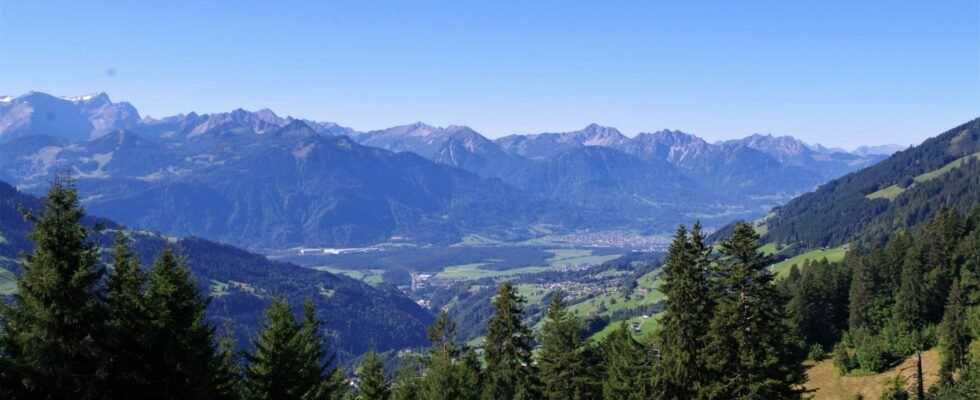A special mountain panorama awaits the hiker on the “Falvkopf” viewing summit in the Großer Walsertal. In January 1954 there was a devastating dust avalanche there.
A quiet autumn hike with many beautiful views leads to the rarely used Falvkopf in the Großer Walsertal. The starting point is the Valentschina hiking car park in Blons. About one kilometer after the village center in the direction of Damüls, turn left from the main road and follow the single-lane road further uphill. This route is subject to a toll, authorization cards can be purchased for six euros in the village shop or in house no. 40 (signposted with toll station).
The small gravel parking lot is soon reached. From there it goes on foot following the white-red-white markings in the direction of Falvkopf. First of all, a forest path climbs slowly through the forest, passing tufa-lime springs. Precipitations of calcareous sinter (tufa) in the immediate source area are characteristic of these waters. This process is reinforced by algae and mosses, which additionally remove carbon dioxide from the water through photosynthesis.
Type: half day hike
Duration: 2.5 to 3 hours
Ascent: approx. 560 m
Starting point: Valentschina hiking car park – toll (6 euros), but the tour can also be started from the center of Blons (plus 2 hours)
Equipment: daypack, ankle-high shoes with good treaded soles, sun / rain protection, drink and snack
Info: Due to the current weather conditions, there is snow in the summit area.
Refreshments: Blons
The plants near the source are covered with a thin crust of precipitated calcium carbonate and so filigree, porous limestone forms over time. Due to the permanent resettlement of the limestone crusts by moss, the stones can “grow” and form the typical channel shapes. Due to their rarity and small areas as well as the local flora and fauna, tufa springs are often designated as natural monuments or habitats worthy of protection. The fragile biotopes can be severely damaged by foot traffic, so you should marvel at them from a suitable distance.
Fantastic views
After about 40 minutes of walking through wooded area, you will reach a clearing with a rustic wooden house. From here you already have a beautiful view down into the valley. The signs show the way and after the house it goes uphill sharply to the right.
After a few meters you come to an unmarked junction – if you want to go to the Falvkopf, pass it and continue following the white-red-white markings that finally lead the hiker uphill on the left. A little later you will reach the hut of the torrent and avalanche barriers. From there you can choose between two different ascent routes. The left one leads from the west to the summit, the right path meanders in many curves through the forest up to the mountain.
Swallowwort gentian
The plant is popularly known as the blue carpentery, autumn gentian and stag rutting gentian (due to the late flowering). The swallow root gentian reaches a height of up to one meter and forms upright to overhanging, multi-flowered stems. The plant thrives in valleys and at heights of up to 2000 meters and prefers moist meadows, forest edges, flat moors and calcareous soils. The flowering period extends from August to October. Due to the intensive cultivation of fresh and wet meadows, the swallowwort gentian is considered endangered in some places.
The avalanche year 1954
Avalanche barriers are repeatedly passed. There is a good reason for this: on January 11, 1954, after heavy snowfall, an avalanche of dust came off the Falvkopf. 82 residents from a total of 14 farms were buried, 34 of them died in the snow masses. In those fateful January days, several devastating avalanches occurred across the country. The winter of 1953/54 had started mildly. According to the chronicle, it was still unusually warm in December and even spring flowers were sprouting. From January 8th, however, surprisingly heavy snowfall set in – up to two meters of fresh snow fell within 24 hours. Due to the mild temperatures that had previously prevailed, these large quantities could not bond with the subsoil and the danger of avalanches increased dramatically. By January 12th, around 400 avalanches had occurred across the country. A total of 125 people lost their lives and numerous buildings were destroyed. As a consequence of this natural disaster, the construction of extensive avalanche barriers began. At the Falvkopf, these reach just below the summit cross.
The way there is partly overgrown and not clearly visible in places, which requires full mindfulness. You only step out of the forest shortly before your destination. The ridge is lined with a field of blueberry bushes, the leaves of which are now glowing red in the autumn sun. From the 1984 meter high summit there is a fabulous panorama of the villages of the Großer Walsertal, the Walgau and the neighboring mountain peaks. A bench invites you to rest. Here you can take in the wonderful view in peace. You can return either via the same route or alternatively via the Falvkopf circular route (signposted).
